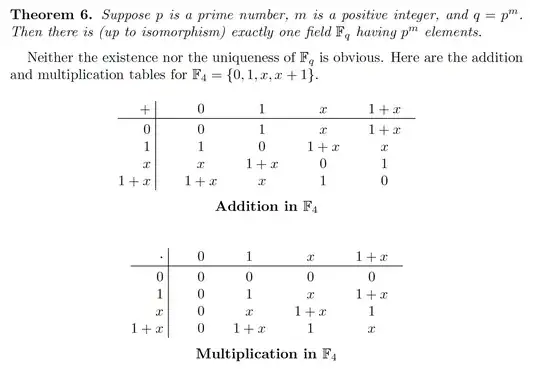Could anyone explain the example below? Why is $F_4 = $ {$0,1,x,x+1$}? (I was learning that it should be $F_4 = $ {$0,1,2,3$}). And how do we get the two tables?
-
@RobArthan Indeed 2 has no multiplicative inverse, not thinking things through... – Doug M May 11 '18 at 19:41
3 Answers
$\Bbb{F}_4$ is the finite field of order $4$. It is not the same as $\Bbb{Z}_4$, the integers modulo 4. In fact, $\Bbb{Z}_4$ is not a field. $\Bbb{F}_4$ is the splitting field over $\Bbb{F}_2 = \Bbb{Z}_2$ of the polynomial $X^4 - X$. You get the addition table by observing that $\Bbb{F}_4$ is a 2-dimensional vector space over $\Bbb{F}_2$ with basis $1$ and $x$ where $x$ is either of the roots of $X^4 - X = X(X - 1)(X^2 + X + 1)$ that is not in $\Bbb{F}_2$. You get the multiplication table by using $x^2 + x + 1= 0$ to simplify the expressions for the products of $x$ and $x + 1$.
- 48,577
-
2I'm self-studying this topic, and was a bit lost when the author of the note above jumped straight from prime fields to non-prime fields. It is my observation that if we classify the finite fields $\mathbb{F_n}$ by their cardinalities $n$, then if $n$ is a prime number $p$, $\mathbb{F_n}$ coincides with the prime field $\mathbb{F_p}$. Otherwise, if $n$ is not prime, we must find $n$ polynomials in place of natural numbers ${0,1,2,...,(n-1)}$ to construct the field. Is this observation correct? – ensbana May 12 '18 at 09:25
-
1Also if this is true, how do we find the irreducible polynomial in question? – ensbana May 12 '18 at 09:25
-
2There is a finite field with $n$ elements iff $n$ is a prime power. The field with $p^k$ elements is the splitting field of $x^{p^k} - x$ and its elements comprise precisely the $p^k$ distinct roots of that polynomial. See https://en.wikipedia.org/wiki/Finite_field for more info. – Rob Arthan May 12 '18 at 11:30
-
When you say x is either of the roots of $X^2+X+1$ that is not in $F_2$... this would imply that this polynomial factors as $(X-x)(X-x-1)$ based on the table above... but over the complex numbers the two roots of this polynomial don't seem to differ by just $1$... What am I missing here? – gen May 13 '22 at 01:53
-
-
@RobArthan. I see. Could you expand on this a bit more? Is it not possible to see these $x$ and $x+1$ as elements of $\mathbb{C}$? Are they not "numbers"? – gen May 13 '22 at 02:01
-
@gen: The question is about finite fields, specifically, the field $\Bbb{F}_4$. – Rob Arthan May 13 '22 at 02:06
The question is about the unique (up to isomorphism) field with four elements. Assuming that such a field exists, then its addition and multiplication tables are uniquely determined by the field axioms. More precisely, under addition it is an Abelian group. So it must have the elements zero and one. The first question is what is the additive order of one? It must be a divisor of four, so it is either four or two. In the first case, it must be that $\;\{0,1,$ $2:=1+1,$ $3:=2+1,$ $4:=3+1\}\;$ but there are only four elements so it must be that $\,4=0\,$ since it can't equal any of the three other elements. This implies that $\;2\times 2=4=0,\;$ so zero divisors exist and thus it can't be a field.
The only other possibility is that $\;1+1=0\;$ which implies that there are two other elements. Call one of them $\;x\;$ and the other is $\;x+1\;$ since it can't equal any of the other three elements. In the same way, $\;x+x=0\;$ since it can't equal any of the other three elements. This is enough to uniquely determine the sixteen entries in the addition table.
For multiplication, the defining properties of zero and one determine twelve of the entries in its multiplication table. We get $\;x\times x = 1+x\;$ since it can't equal any of the other three elements. We also get $\;x \times (1+x) = 1\;$ since the multiplicative inverse of $\;x\;$ can't equal any of the other three elements. Finally, $\;(1+x)\times(1+x)=x\;$ and we are done.
- 35,251
- 3
- 30
- 76
I believe that this is $\mathbb{Z}_2[x]/(x^2-x-1)$ which is a field. This is seen to be a field as follows. Since $\mathbb{Z}_2[x]$ is a PID (polynomial rings over fields are always PIDs) and $(x^2-x-1)$ is a prime ideal it follows it is maximal (Because we're in a PID). Since the quotient of a ring by a maximal ideal is always a field, $\mathbb{Z}_2[x]/(x^2-x-1)$ is a field. The way I was able to tell that we quotiented by the polynomial $x^2-x-1$ was from, in this case, seeing $x^2=x+1$ in the multiplication table.
From this perspective we can tell where the addiction and multiplication tables come from. We just add, or multiply, the polynomials together in $\mathbb{Z}_2[x]$ and get $f$ for example. Then we look at the remainder of $f$ when its divided by $x^2-x-1$ and thats our answer.
